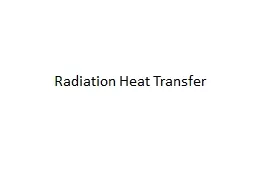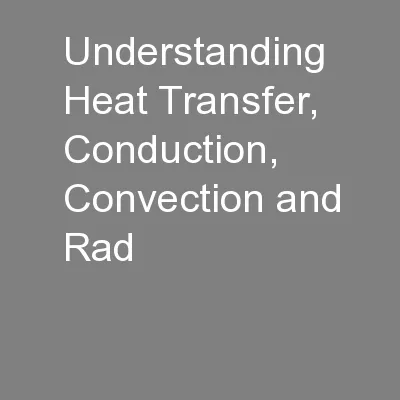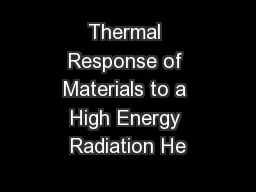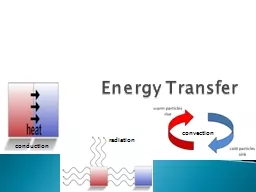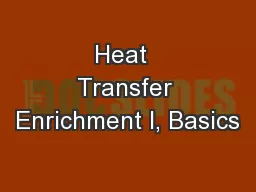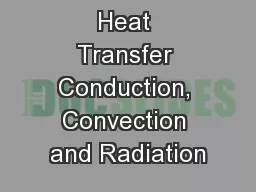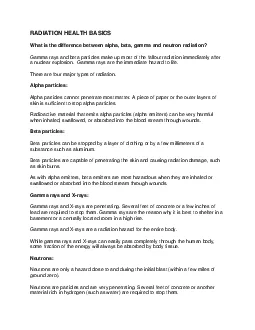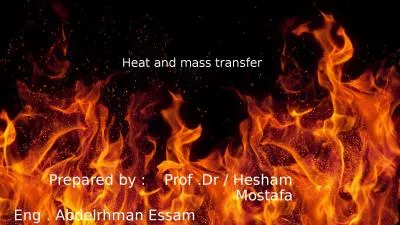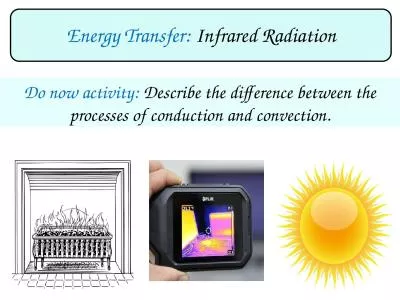PPT-Radiation Heat Transfer The third method of heat transfer
Author : olivia-moreira | Published Date : 2018-03-23
How does heat energy get from the Sun to the Earth There are no particles between the Sun and the Earth so it CANNOT travel by conduction or by convection RADIATION
Presentation Embed Code
Download Presentation
Download Presentation The PPT/PDF document "Radiation Heat Transfer The third method..." is the property of its rightful owner. Permission is granted to download and print the materials on this website for personal, non-commercial use only, and to display it on your personal computer provided you do not modify the materials and that you retain all copyright notices contained in the materials. By downloading content from our website, you accept the terms of this agreement.
Radiation Heat Transfer The third method of heat transfer: Transcript
How does heat energy get from the Sun to the Earth There are no particles between the Sun and the Earth so it CANNOT travel by conduction or by convection RADIATION How can we relate our new understanding to the greenhouse effect. Aim. Calculate local natural convection heat-transfer coefficients for a sphere. Calculate the local boundary layer . Calculate experimental mean Nusselt number. Compare experimental and theoretical Nusselt numbers. Heat Transfer. Heat always moves from a warmer place to a cooler place.. Hot objects in a cooler room will cool to room temperature.. Cold objects in a warmer room will heat up to room temperature.. Question. Dr. Matthew C. Carroll. Texas A & M University at Galveston. 2011 Thermal and Fluids Analysis Workshop. Passive Thermal Session #1. Newport News, Virginia, August 2011. What are we doing?. The Big Picture. . conduction. c. onvection. radiation. Energy can be transferred from one system to another (or from a system to its environment) in different ways: . Thermally. , when a warmer object is in contact with a cooler . CERT Educational Series. Greg Monty PhD, Vicki Foust PhD, and Elizabeth . Keele. . M.Ed. Why Does Ice Melt?. We have a glass . of . water. The temperature of . tap water . is about 21 ºC . The temperature of . To Make Foldable:. 1. On the short side of the paper, fold it down an inch.. 2. Now fold it in half, hamburger style.. 3. Now fold it in 1/3.. Conduction. Convection . Radiation. Heat Transfer. Examples. Conduction Convection . Radiation. Types of Heat transfer. Heat Transfer. Heat can be transferred in 3 ways. Conduction. Convection. Radiation. Heat flow depends on the temperature difference – . flows from hot to cold. transmitted. absorbed. reflected. 1. transmission. Radiation passes through atmosphere unimpeded.. Shortwave and longwave “windows” . 2. absorption. Energy is transferred to absorber; absorber emits energy. La gamme de thé MORPHEE vise toute générations recherchant le sommeil paisible tant désiré et non procuré par tout types de médicaments. Essentiellement composé de feuille de morphine, ce thé vous assurera d’un rétablissement digne d’un voyage sur . What type of radiation is most harmful It depends on whether your exposure to radiation is internal or external beta particles Radioactive materials thatRadiation can affect the bodyThese adverse hea Radiation refers to the process that is concerned with the passage of energy between places through space. . It is the radiation generated by sun that . regulates the temperature of earth. . . CLASSIFICATION OF RADIATION: ionizing or non-ionizing types. . •. Radiation biology . is the study of the action of ionizing radiation on living organisms . •The action is very complex, involving physics, chemistry, and biology . –Different types of ionizing radiation . . Eng. . Abdelrhman Essam. Free convection and Radiation. Convection . Convection Heat transfer can be classified into;. 1- forced convection . 2- free convection.. Introduction to free convection. Do now activity: . Describe the difference between the processes of conduction and convection.. GOOD PROGRESS:. Describe some sources of infrared radiation. Explain how energy is transferred by radiation.
Download Document
Here is the link to download the presentation.
"Radiation Heat Transfer The third method of heat transfer"The content belongs to its owner. You may download and print it for personal use, without modification, and keep all copyright notices. By downloading, you agree to these terms.
Related Documents

